
Martha Washington To Melania Trump: How US First Ladies Through History Have Harnessed The Power of Fashion
- Published By The Statesman For The Statesman Digital
- 2 hours ago
As Michelle Obama's The Look is published, we dissect first-lady fashion through the decades. From "mother of the nation" to Flotus fashionistas, what have their unique styles signalled about themselves, their role and their eras?
"The look, like the woman, was bold, powerful, forward-looking, visionary, and empowering for everyone who dares to believe in the possibility of better tomorrows," writes African-American studies professor Farah Jasmine Griffin in the foreword to The Look, the new book charting Michelle Obama's style evolution. Featuring the voices of longtime stylist Meredith Koop, as well as Obama's makeup artist Carl Ray, hairstylists Yene Damtew and Njeri Radway, it goes behind-the-scenes on the brooches and ball gowns of the White House, through to the double denim of the present day.
It's no small claim for the fashion choices of a woman who was First Lady of the United States (otherwise known as Flotus) from 2009 to 2017, particularly when the task at hand is such a complicated one. But, as Obama recently revealed in an interview with Good Morning America, what she wore wasn't incidental: "I really thought about what I wanted to say with my fashion. I wanted to talk about inclusion, diversity, opening up opportunities, and fashion was one of those tools that allowed me to do that."
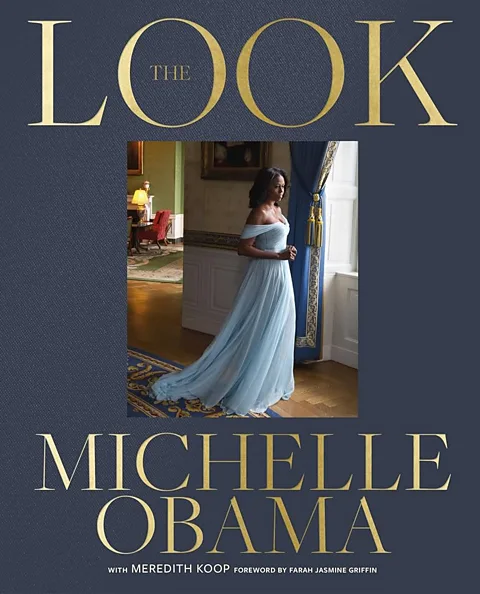 Crown Publishing
Crown PublishingShe must have known that her style would be picked over and analysed, because what the first lady wears has been the subject of fascination and discussion ever since Martha Washington, wife of George Washington, who was the first ever president of the US from 1789 to 1797.
What the US president's spouse wears – and with a woman still to hold the US presidency, all 45 have been "first ladies" rather than "gentlemen" – isn't just a case of aesthetics. While their husbands have been the officeholders, their dress has at times been highly political, a source of diplomacy abroad, or a show of loyalty at home.
"There is no one goal or message that Flotus is trying to achieve through her dress," historian and author of Dressed for Freedom: The Fashionable Politics of American Feminism Einav Rabinovitch-Fox tells the BBC. "Each first lady is different, and her use of clothing is different." Not addressed in the US Constitution, the role of the first lady has evolved over time from being more domestic – "in the early years of the republic (presidents Washington, Madison), the first lady was basically a hostess and a companion" – to more professional, and political.
In the 20th Century, according to Rabinovitch-Fox, "the role became more important, and thus the image and appearance gained importance too"; she believes this was in large part thanks to Eleanor Roosevelt, who was first lady from 1933 to 1945. She was not only the US's longest serving first lady but a towering political figure in her own right.
As Obama recently told People Magazine: "It was a complicated assignment. The role of first lady is a kind of job, non-job. You know that you're supposed to be inspirational, yet accessible. You should be uniquely yourself, authentic, but representational at the same time."
So what have some of the most well-known first ladies worn during their time in the White House – and how have their outfits reflected not just them but their era?
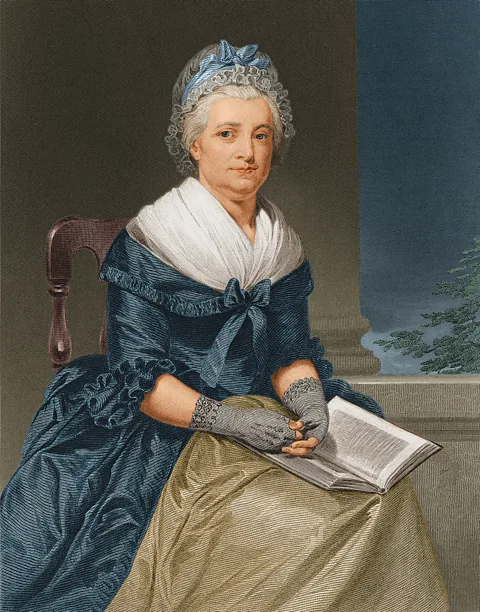 Getty Images
Getty ImagesMartha Washington
The first ever first lady, Martha Washington "really shaped the office," says Rabinovitch-Fox. She had to. As Feather Foster, a presidential historian and author of The First Ladies: An Intimate Portrait of the Women Who Shaped America, tells the BBC, she had no precedent for what to wear except from the style lessons of monarchies. But, given the history, "above all, she and her husband George did not want to be perceived as monarchical." Seen no doubt as a patriotic duty, she had, according to Foster, "worn only clothing made in the US from US fabrics since before the Revolutionary War [1776] and this would never change".
Aged 57 when she became first lady she was, says Foster, "focused on dignity and appropriate behaviour". Her gowns "were usually dark or muted in colour. Black, greys, creams and pale blue in summer. But always of high-quality fabrics. Her jewellery was simple. Tasteful rather than opulent".
"Her style was very matronly," says Rabinovitch-Fox, which "fitted the image of the 'mother of the nation'." Plus, "at a time when very few images circulated in the press and other media, Martha's position as a first lady enabled her image to be popularised, and she became one of the most recognisable women in the 18th Century, which also contributed to the popularisation of her style."
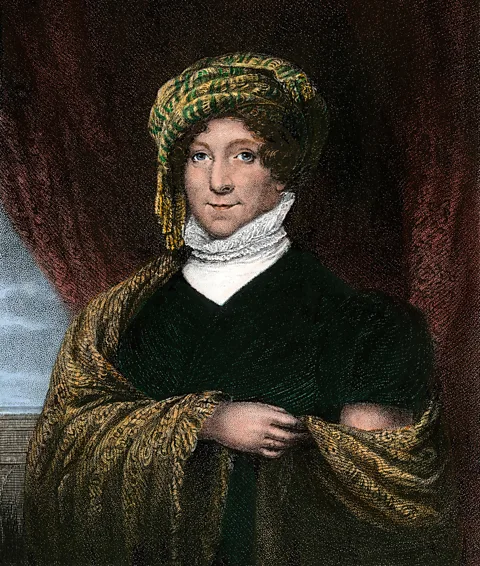 Alamy
AlamyThe wife of James Madison, the fourth president of the United States from 1809 to 1817, Dolley was, according to Rabinovitch-Fox, "maybe our first 'fashionista' first lady". She "set the style, fashion and otherwise, for 40 years," says Foster.
Chief among those trends was a turban-style of headwear – "when she introduced turban hats, every milliner in the country went scurrying" – as well as décolleté dresses showing some cleavage.
But she wasn't just a trendsetter in terms of clothing. A lover of throwing parties, she also, according to Foster, set trends in terms of "what she ate, what she served, where she went, how she furnished their rooms… even how she greeted their guests! Even previous no-nos (using snuff and rouge) became acceptable via Dolley."
It was, she points out, "very political. Her style and personal charm were said to be crucial to her husband's administration. He was small and bland. She was naturally outgoing and tactful."
But, according to Rabinovitch-Fox, "Dolly's love for fashion also got her in some troubles with James, as unlike Martha Washington who wore homespun, Dolly didn't mind dressing lavishly in imported goods that cost her husband much in taxes and tariffs."
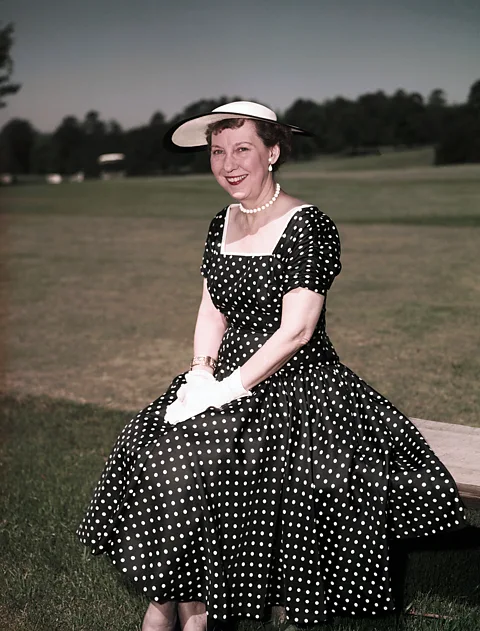 Getty Images
Getty ImagesMary Geneva 'Mamie' Eisenhower
First lady of the United States from 1953 to 1961, "Mamie" Eisenhower was, says Foster, "the epitome of the role in transition". An extremely popular first lady, according to Rabinovitch-Fox, and following on from the war era that saw many women head out into the workforce, she "fitted more to the conservative housewife ideal of the 1950s, and the idea of returning to the home after the strenuous years of the war. She represented "simplicity. She looked like every American woman, and she dressed like every American woman, which made it easier for people to connect to her and relate to her."
She was a champion of the Dior New Look, an ultra-feminine silhouette created by Christian Dior with cinched-in waists and full skirts – perfect for her image as "homemaker-in-chief". She was, says Foster, "not political at all, but she became everybody's grandma in the 50s… taking grannyhood away from the grey hair and apron-wearing Norman Rockwell image of the 30s."
She was also very well known for her love of pink – resulting in a shade known as "Mamie pink" – which was symbolic of the fixed gender roles of the 1950s, and "a new emphasis on femininity and Cold War conservatism that put women back in the home," says Rabinovitch Fox. She wore a pink peau de soie gown embroidered with more than 2,000 rhinestones to the 1953 inaugural ball and a candyfloss-coloured dress with matching opera gloves and a clutch bag for her official portrait.
Her love of little hats made from Ecuadorian straw is said, at one point, "to have boosted the entire Ecuadorian economy because the demand was so great". Clearly a trendsetter, "if not for Jackie, Mamie would probably be remembered today as the most fashionable Flotus we had."
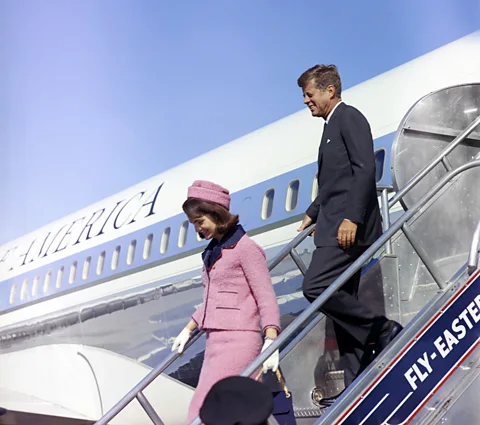 Getty Images
Getty ImagesJackie Kennedy
Arguably most famous of all the first ladies for her sense of style and impact on trends, Jackie Kennedy "really set the golden standard for first ladies, and her style became iconic," says Rabinovitch-Fox. From her sharply cut suits to pillbox hats, her style legacy is something that people still look to, to this day.
Oleg Cassini, the Russian-born US costume and fashion designer to the stars, became her unofficial stylist. She was glamorous, but also tasteful. "Jackie was very young, but her style became 'classical' almost from the beginning," says Rabinovitch-Fox.
Her love of European fashion was in some ways apt in a new era of internationalism and glamour for the US presidency. "She understood fashion in a very profound way," says Rabinovitch-Fox, "and was the first Flotus to use fashion not only to advance her own image but as a form of diplomacy."
Some, though, disapproved of her taste for European style – she even had clothes designed by Chanel, signed off in Paris, but copied and made for her in New York, in a bid to show some loyalty to the US.
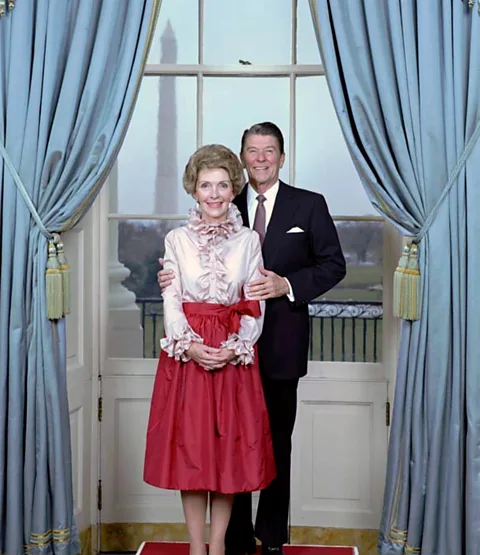 Alamy
AlamyNancy Reagan
Immaculate, high-fashion and luxurious, in line with the opulent 1980s era, Nancy Reagan's wardrobe included looks from European fashion houses such as Chanel, Yves Saint Laurent and Valentino, as well as US names such as Oscar de la Renta, Bill Blass and Carolina Herrera, and she worked closely with the stylist James Galanos.
"If Jackie Kennedy is the standard for first ladies, Nancy Reagan was the standard of conservatism," says Rabinovitch-Fox. She was, after Kennedy, perhaps the first lady most known for her sense of style and the impact she had on inspiring others to follow her trends.
She inherently "got" the power of image and had an address book full of stars and socialites. "Like her husband, [she] was a former Hollywood actress, and she really understood the media and cameras," says Rabinovitch-Fox.
Her style was celebrated – in 1989 the Council of Fashion Designers of America honoured her with its lifetime achievement award – as well as criticised; in an era on the brink of economic downturn, some questioned her opulent designer tastes. She was perhaps most famous for her use of the colour red, which became known as "Reagan red" or "Nancy Red", once saying, "I always liked red. It's a picker-upper."
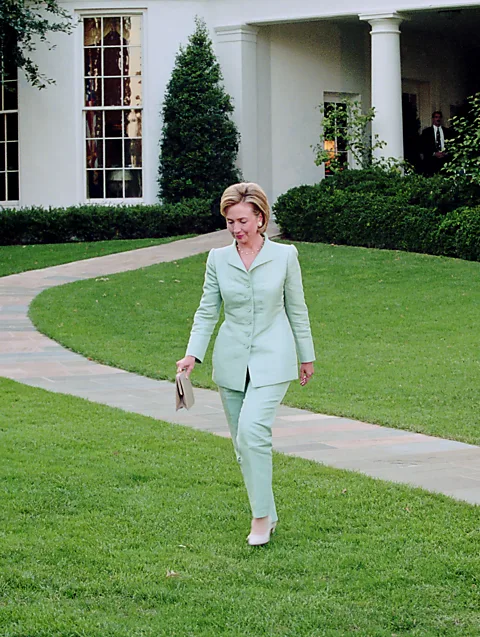 Getty Images
Getty ImagesHillary Clinton
First lady between 1993 and 2001, Clinton set a new precedent when it came to the involvement of a first lady in public policy and her professional trouser suits were the sartorial embodiment of this approach. Though not the "first Flotus to wear pants [trousers]," according to Rabinovitch-Fox, "she certainly adopted them as part of her image," and "she is the first to appear in her official portrait with a pantsuit".
She is also a longtime fan of the headband, an accessory that can be pure adornment but on her feels functional; signalling a down-to-business spirit. The "Hillary Headband" speaks to her position as one of a new generation of political spouses who fulfilled a domestic function but also had a job, in her case as an attorney.
Not known for her impact on fashion during her time in the White House – and frequently subject to sexist criticism in the media for her appearance – "she had a conflicted relationship with fashion as a first lady, and only began to understand its role and importance when she became a political actor in her own right," says Rabinovitch-Fox.
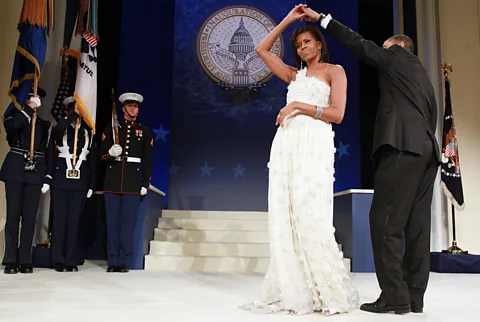 Getty Images
Getty Images"Like Jackie, she became a style icon from the start, says Rabinovitch-Fox. But unlike Jackie, it is not for luxury style that Michelle Obama is known. "Coming to the White House in the midst of an economic crisis, Obama became known to present an accessible image, wearing off-the-rack popular brands like Target and J Crew," she says, "while supporting young American designers, who often saw a boost to their business after Obama wore their design." All of which speaks to her understanding of fashion as representative of politics and identity, as well as how it could be used as a tool to advance her husband's political agenda.
Her hair was often the subject of discussion. "As a black woman, Obama served as an inspiration, but she was not immune from criticism," says Rabinovitch-Fox. While recently she has been embracing braids, as she recently told People magazine of the fact she avoided these styles during her time in the White House: "I wasn't sure whether the country was ready for it. The Crown Act [which protects employees and students from race-based hair discrimination] hadn't been passed yet, and just like fashion, I didn't want my hair to become a distraction." As Rabinovitch-Fox puts it: "After leaving the White House, she literally let her hair down."
Read Also: Top 5 Plastic Surgery Procedures Among Kenyan Women Today
Obama's sometimes bare arms came under criticism, too. As she told People magazine in a recent interview about her new book: "I took it for what it was, pure hypocrisy. I could pull up pictures of Jackie O in a second and see this fashion icon in sleeveless dresses as first lady. So at a point you're like, 'Oh, this is politics. If you can't beat them, make everybody scared of them.' That was the motto."
Obama also understood the need to not take up all the oxygen via her wardrobe. A "famous person", but not a "starlet", that meant, she said, that "the clothes could never speak louder than anything I had to say".
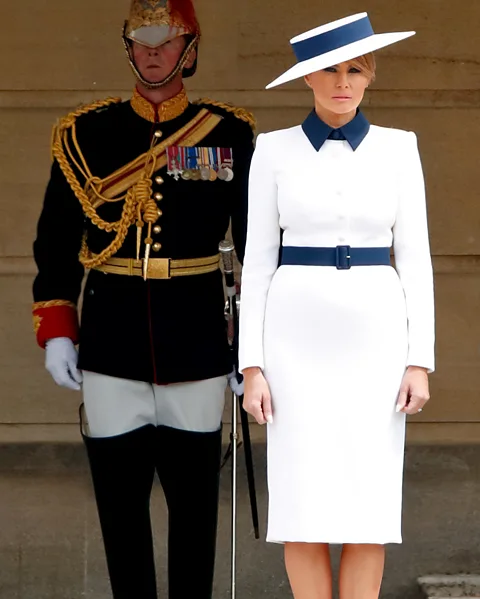 Getty Images
Getty ImagesTailoring, tightly belted trenchcoats and sharply cut tuxedos are often her style of choice. Occasionally military-inspired, always highly polished and glamourous, Melania Trump's style has been the subject of both adulation and consternation.
For some, she is the epitome of first lady style, for others, she embodies something else. She famously wore sky-high heels en route to visit the site of a natural disaster and a pith hat – a symbol of colonial rule – on safari in Kenya. Some point to her extravagant tastes – many of her outfits have price tags running well into the thousands. But perhaps most famously there was a jacket she wore on a visit to a child migrant detention centre in 2018 that read "I really don't care. Do u?" a message she later said was directed at the "leftwing media".
Trump's wardrobe is picked over perhaps all the more given it is often the only communication tool she uses. "Melania is not known as a great speaker, which made her fashion choices even more important, because many times, that was her form of speech," says Rabinovitch-Fox. And "as a former model, she is of course not a stranger to fashion, and she knows very well how to use clothes."
"In general, I think that today, first ladies understand the power of fashion, and are trying to build an image for them that represents the country, but also theirs, and their husbands' agenda," says Rabinovitch-Fox.
It remains to be seen how this dynamic may shift when the US inaugurates its "first gentleman".
The Look by Michelle Obama is published by Crown Publishing Group in the US and Viking Press in the UK.
Share on
SHARE YOUR COMMENT
MORE STORIES FOR YOU
Trending Stories
DJ Mo’s former illicit lo...
- Published By Jane
- January 15, 2024
Mapenzi! Zari and Tanasha...
- Published By Jane
- October 24, 2023
Zuchu Speaks on Diamond P...
- Published By Jane
- October 12, 2023
Hio Ni Upumbavu Wasituche...
- Published By Jane
- November 8, 2023
RECOMMENDED FOR YOU
How People are Using AI t...
- Published By The
- October 29, 2025
How Raila Odinga’s Death...
- Published By The
- October 29, 2025
What is Ayurveda? Raila O...
- Published By The
- October 29, 2025
Why Parents Should Spend...
- Published By The
- October 29, 2025
Latest Stories
Former Nairobi Governor E...
- Published By Jedida
- November 6, 2025
Ali Kiba Apologises For S...
- Published By Jedida
- November 6, 2025
Cassypool Continues To Dr...
- Published By Jedida
- November 6, 2025
Safaricom Reports A 42.8...
- Published By Jedida
- November 6, 2025



